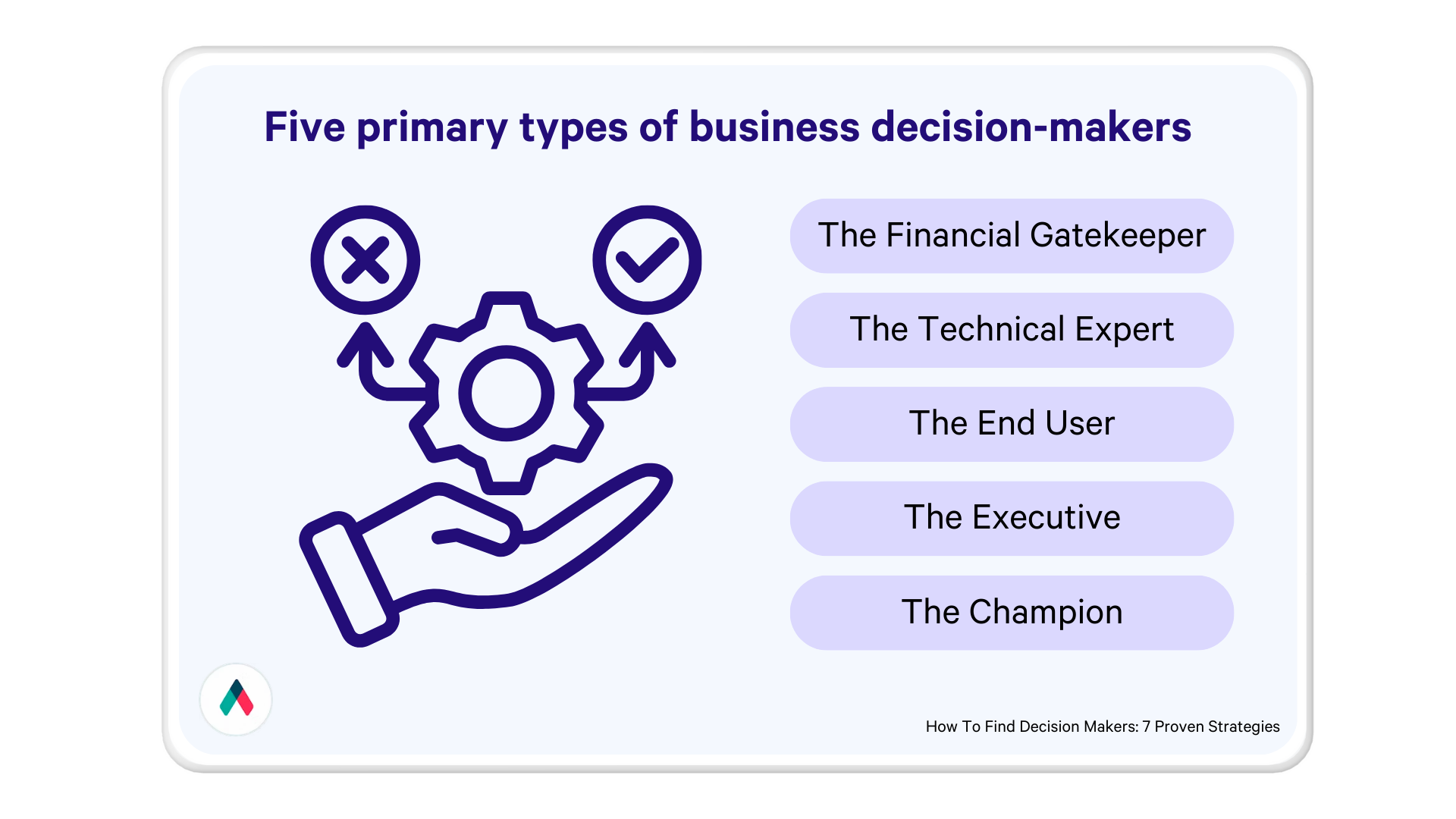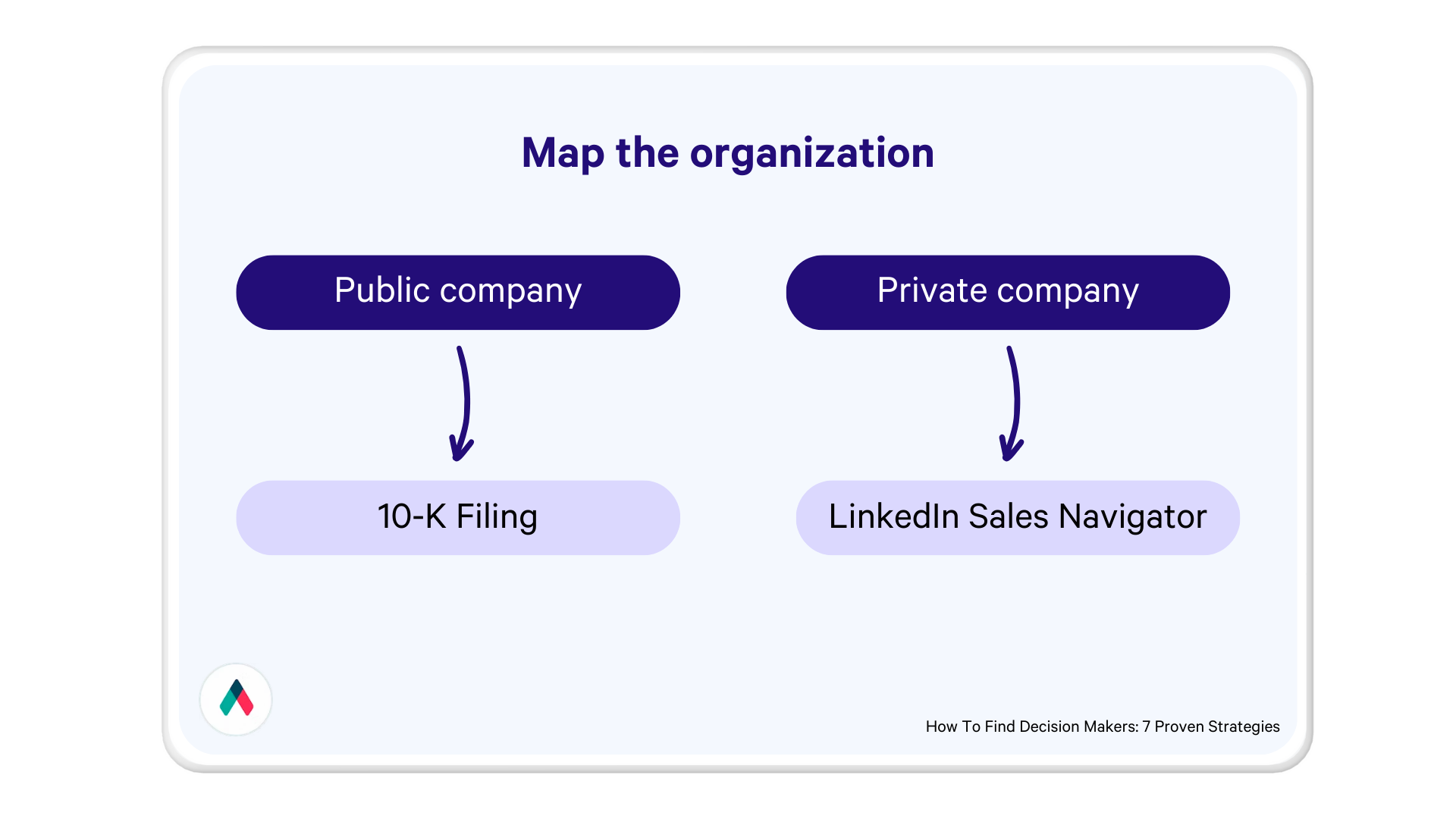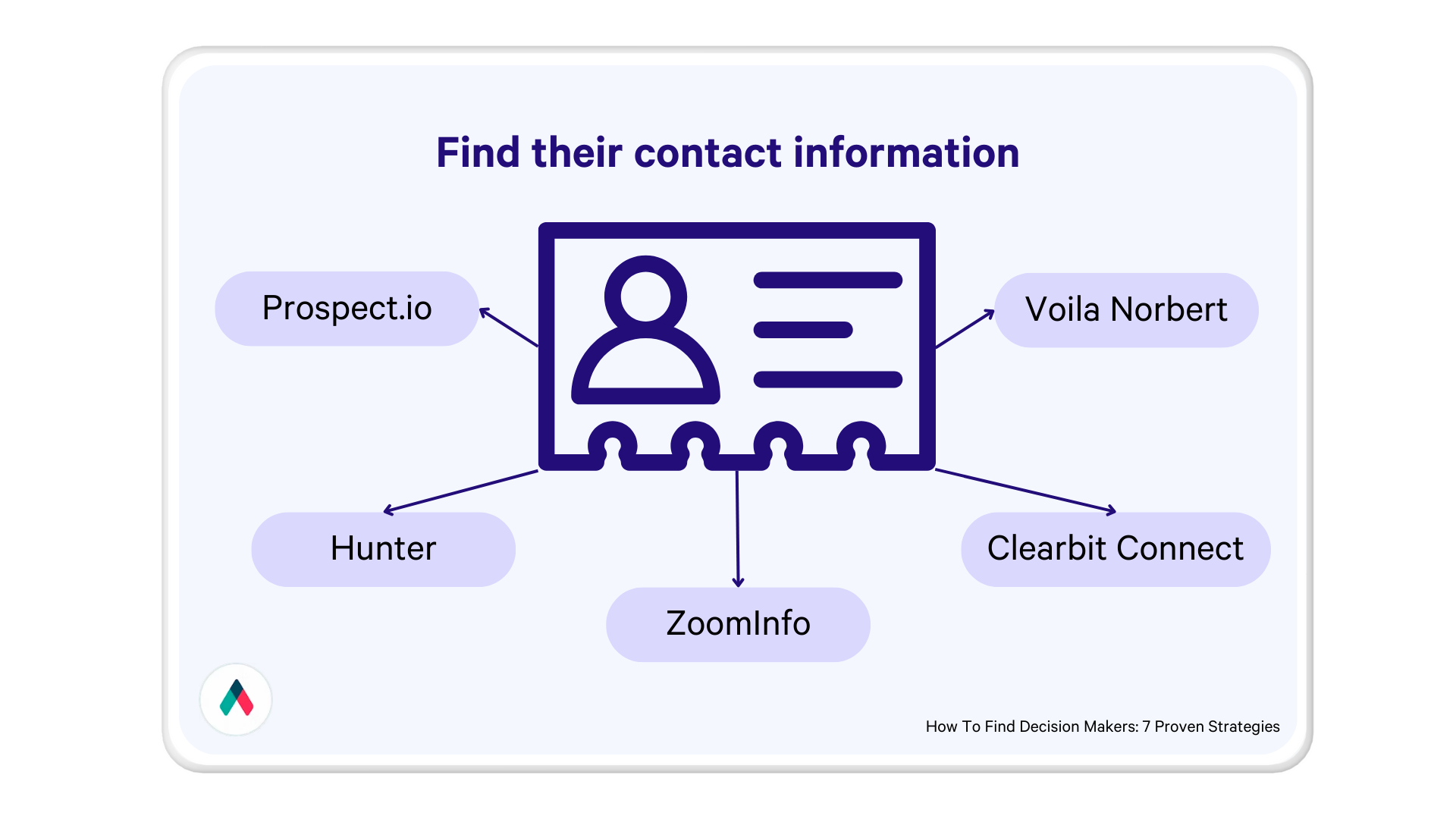You’ve spent weeks crafting the perfect pitch. Your product or service is unparalleled, and you're confident it can bring immense value to new customers. There's just one small problem: you’re presenting to someone who, despite their interest and excitement, doesn't have the authority to seal the deal.
Finding the person who can sign off on the purchase and targeting them from the get-go will make the most of your time AND your prospects. If this seems like it’s easier said than done, it doesn’t have to be. Here are seven tips to help you reach decision-makers and stave off those final decision stalemates.
Five primary types of business decision-makers
Every organization, whether a startup or a multinational, operates with a decision-making hierarchy. Identifying and understanding the different types of decision-makers can significantly enhance your approach and the effectiveness of your pitch. By knowing whom to approach, when, and how, you can streamline your efforts and make more meaningful connections. Let's delve into the five primary types you will most likely encounter in your B2B journey.

1. The Financial Gatekeeper
Typically donning a C-level title like CFO, COO, or Chief Revenue Officer, these individuals guard the organization's purse strings. Before you even get to this person, you might have to go through a procurement team member or a Director of Finance. Regardless of the specific title they bear, their primary concerns revolve around budgets, profitability, and financial health. They evaluate all purchasing decisions for their financial implications: Will this yield a strong ROI? Is it a sound investment?
When dealing with financial gatekeepers, come to your sales conversations prepared with data. Highlight cost savings, potential revenue growth, or any financial incentives your solution offers. ROI projections, case studies, and cost-benefit analyses can be persuasive tools in your arsenal.
2. The Technical Expert
Often carrying titles like CTO, Technical Director, or Lead Engineer, these key stakeholders are the tech gurus of the organization. They're interested in the nuts and bolts—how a product functions, its integration capabilities, scalability, and compatibility with existing systems.
This group welcomes technical jargon that might alienate others. Be prepared to get into the nitty-gritty details. Offering live demos, technical whitepapers, or even access to your product's API documentation can be beneficial. They appreciate transparency and thoroughness.
3. The End User
This group is typically found in managerial or team lead positions and represents the people who will actually use your product or service daily. Their concerns are hands-on and practical. They ask: How will this impact our daily workflow? Is it user-friendly? Will it solve our current challenges?
For end users, a hands-on approach works best. Offering product trials, training sessions, or in-depth demos can be effective. Gather feedback during these trials and be ready to showcase how your product can be tailored to meet their specific needs.
4. The Executive
These top-tier decision-makers include roles like CEO, COO, CMO, or President. Their perspective is macro. They're interested in how decisions align with the company's vision, mission, and long-term strategy.
When engaging with executives, be concise and strategic. Highlight how your solution aligns with the company's broader objectives and how it can offer a competitive edge in the market. Anecdotal success stories from similar industries or competitors can be particularly compelling.
5. The Champion
While not necessarily at the top of the hierarchy, champions are influencers within the organization. They could be mid-level managers, team leaders, or even enthusiastic salespeople who see the potential in your solution. They're your internal advocates and can rally support for your cause.
Cultivate a strong relationship with champions by providing them with all the tools they need to advocate for your solution. This could include presentations, internal marketing materials, or data that supports their arguments. Remember, their success in championing your product is mutually beneficial.
Understanding the nuances of each decision-maker type allows for a more tailored, effective engagement strategy, enhancing your chances of a successful partnership.
How to identify key decision-makers
Learn the kind of companies and buyers you're looking for
If you haven't done this exercise, identifying your ideal customer and buyer persona is critical in kicking off the sales process. Both of these will impact who you’re targeting and how. Not all companies (or buyers) are alike. Depending on the size of the company, you may need to look for different types of individuals who oversee the purchase decisions:
- Companies with less than ten employees: Usually, the CEO is the decision maker unless the company has co-founders or was quick to hire experienced leadership, such as VPs or CMOs.
- Companies with up to 50 employees: VPs of departments are usually the decision-makers.
- Companies between 50 and 500 employees: As companies grow, they usually add specialized roles like Sales, Marketing, or Business Development Managers. Those roles are typically the decision-makers at companies of this size.
- More than 500 employees: Find some kind of regional or specialized role. For instance, an East Coast, North American Rep, or someone tied to a specific department.
Once you've figured out the job title of your decision-maker, it's time to start defining a decision-maker persona. Having personas helps you understand your buyers' motivations and where you might find or approach them. Sometimes, getting face time with a decision-maker is more challenging than finding out who they are. As you define your personas, consider things like:
- What kind of duties do they have in their day-to-day job?
- How long have they been working at the company?
- How do they make decisions? Do they sign the paperwork right then and there? Do they research and pass it on to finance? Are they the end-users?
- How do they interact with your product? Do they visit your company website and read your blog? Do they read your emails? Where do you reach them most, and how do they prefer to communicate?
- Where do these people hang out? What are they reading, listening to, or focusing on?
Knowing this information is helpful because you can use it to customize your outreach strategy and have more success detecting and understanding your buyer's motivations.
Leverage LinkedIn
Of course, you shouldn’t neglect the business world’s answer to social media. LinkedIn is one of the best resources for seeking out decision-makers. If you can, having common connections facilitate here creates a vote of confidence for you in the eyes of the decision-maker.
It takes about eight cold call attempts to reach a prospect. But it's no longer a cold call if someone is willing to introduce you. If you can find a direct connection, taking a look through profiles of top positions at the company you're looking to make a movement with is a great strategy. Here are a few things to look for when you use LinkedIn and what they mean:
- How long have they been with the company? If a CMO only has two months of tenure, but the Director of Marketing has been there for three years, the latter will likely have more buying power and influence.
- How are they endorsed? Endorsements give you a picture of what tools they use, their managerial skills, or any tactical skills that would help the buying process.
- What did they write in their profile? Do they mention being the manager of the strategy for their department? If so, that's a pretty good sign you've found who you want.
Map the organization
If you've churned through LinkedIn and are still having trouble figuring out who is best to reach out to, the next step is mapping out the organization you’re targeting. Finding this information can be pretty straightforward when looking at a public company. You can take a look at their 10-K filing.
If it's a private company, you can use things like LinkedIn Sales Navigator's advanced searching—they even have sorting with decision-maker relevance now.

When you have a map of the organization, you have a clear picture of the decision-makers, gatekeepers, and influencers. You then know who to target with your communications.
Read the news
If you like to take a more proactive approach, reading the news is the best way to stay in the know of who the people in charge are. In technology and start-ups, roles are always shifting—things are a bit more dynamic than in SMBs or enterprise organizations.
Subscribing to newsletters about your industry and your prospects gives you the upper hand. You'll know about changing roles, new hires, mergers, acquisitions, and IPOs without having to dig deep on LinkedIn or constantly monitor local business journals.
Not only does this give you a leg up on finding decision-makers, but it will also help you out with knowing about funding status. People are much more likely to be willing to buy new software if they feel fiscally comfortable. It also gives you a tool to take your relationship one step further: you can reference your knowledge and align with how they may feel about the changes.
Befriend the gatekeeper
In a medium-sized company, an average of 7 people are involved in most buying decisions. If you still can't find a decision-maker, it can be an excellent strategy to find the next best thing: the gatekeeper or an influencer.
From the work you've already done on LinkedIn, org mapping, and reading the news, you should understand the company's layout. Whether you need to find a decision-maker or find their contact information, the gatekeeper or an influencer should be your best friend.
Instead of trying to work against them, acknowledge their job and help them achieve it. They have a tough job—appreciate them and build a candid and real relationship with them. If you can earn an influencer's or gatekeeper's trust, it will help you have a closer relationship with the decision-maker once you reach them.
Use marketing data
Things are moving away from in-person. Currently, 92% of all customer interactions happen over the phone. You can't always read people's body language like you would at a meeting. That said, you can still find patterns and read the body language of content consumption and web movement.
Of high-performing sales teams, 53% rated themselves as effective users of analytics.
Use the marketing data at your fingertips to uncover a potential decision maker's consumption patterns. For instance, are they doing a lot of software discovery—are they viewing G2 Crowd, competitor's sites, or making many comparisons?
Based on this behavior, you can determine whether or not it makes sense to reach out to the person you've found or if it would be better to find someone else to talk with.
Find their contact information
Once you've found the person who makes the decisions, you're 75% of the way there. That's the hardest part! You might think that the most challenging step is finding out how to get in touch with them, but luckily, there's tons of software out there to help you with this integral last step before reaching out.
Beyond tools like LinkedIn Sales Navigator, Salesforce, or PersistIQ, which help you find the person to talk to, here are a few tools that you can use to find out how to talk to them.

- Prospect.io: offers contact information search for decision-makers and tools for outreach and automation.
- Hunter: all you have to do is type in a domain; this tool returns every email address associated with it.
- ZoomInfo: This is one of the OG databases for contact information. Not only do they offer emails and phone numbers, but they also have a connector with LinkedIn Sales Navigator for decision-maker discovery.
- Clearbit Connect: This integrates directly with your email with extensions for Outlook and Gmail.
- Voila Norbert: Like Hunter, all you have to do is type in a decision maker's name and company; this tool will give you their email address.
You're bound to find the necessary information with one of these tools.
The final word
Remember that the journey to connect with the right decision-maker is a blend of tenacity and adaptability. Didn’t strike gold on your first attempt? No worries. Simply pivot and try a fresh tactic from our arsenal. As with everything in sales, nothing pays off more than persistence!
Luckily, in today's digital age, a treasure trove of tools awaits to simplify and supercharge your quest- from automation to our easily-customizable proposal templates.
But these should be leveraged to save time, not leaned on too heavily- always cherish the power of genuine relationships across the organization. After all, meaningful connections are about more than just who holds the corporate card!
About the author

Brendan Connaughton|Head of Growth Marketing
Brendan heads up growth marketing and demand generation at Qwilr, overseeing performance marketing, SEO, and lifecycle initiatives. Brendan has been instrumental in developing go-to-market functions for a number of high-growth startups and challenger brands.
FAQs
Identifying the type of decision maker ensures that your pitch or presentation aligns with their specific pain points and priorities. Tailoring your approach based on the decision maker can greatly enhance the effectiveness of your engagement and increase the chances of securing a deal.
Absolutely. Large deals, especially in big organizations, often require the approval or input of various decision-makers. For instance, a software solution might need the nod from both a Technical Expert and a Financial Gatekeeper before getting the final approval from an executive.
In scenarios where there's a conflict of interest, it's vital to facilitate open communication. Understand the concerns of both parties and seek a middle ground. Demonstrating flexibility in your solution to cater to both high-level strategic goals and day-to-day practicalities can be beneficial in the decision-making process.
Yes, the article highlights the primary five types, but organizations can have other influencers and decision-makers depending on their size, structure, and industry. Examples include external consultants, gatekeepers, or even regulatory authorities in some sectors.


